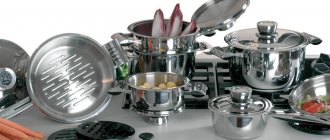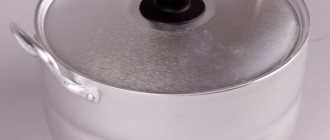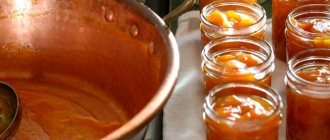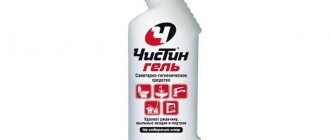Dishes will last longer if you care for them properly. It is rarely possible to avoid plaque formation. Therefore, you should know what to do to solve such a problem. The choice of the appropriate method will be influenced by the material of the pan and the nature of the formation that appears on it. This will prevent damage to the utensils. You should study in more detail how to clean an enamel pan from dark deposits inside.
You can avoid damage to the dishes by avoiding cooking foods with a thick consistency in them.
Caring for enamel equipment
Enamel is highly sensitive to temperature changes. Do not fill hot utensils with cold water. This will cause cracks to form on the surface. The pan should be washed thoroughly after each use. If the initial stage of plaque formation is detected, it is recommended to immediately begin eliminating it. This will allow you to get rid of contamination faster and more efficiently.
You can avoid damage to your cookware by avoiding cooking foods with a thick consistency in it. Then nothing will burn in the enamel utensils. Do not use hard brushes when cleaning, they may damage the surface.
Before first use
Before use, it is not enough to simply rinse new enamel cookware. Experienced housewives strengthen the coating in this way: they boil a saline solution.
- Pour 2 tbsp into the bowl. regular salt per 3 liters of water.
- Cover the pan with a lid and boil for 15 minutes over low heat.
- Remove from heat and let cool. Drain the solution and rinse the container with warm running water.
During use, pans acquire carbon deposits and soot. You have to scrub them off the yellow coating inside.
Types of plaque on enamel pans
To choose an effective method for cleaning enamel pans, you need to find out the type of plaque. This will allow you to use the most appropriate method and eliminate contamination faster.
Black
Appears when food burns. It will take a lot of effort to get rid of the black layer.
You should carefully remove the black layer so as not to scratch the coating inside the cookware.
To prevent plaque from forming again, you need to carefully ensure that it does not burn in the future.
You should carefully remove the black layer so as not to scratch the coating inside the cookware.
Yellow
Yellow discoloration inside the pan appears due to the use of hard water. It begins to appear unnoticed, and often the problem is noticed already in advanced situations. You should carefully study effective ways to combat yellowness specifically for enamel utensils.
Yellow discoloration inside the pan appears due to the use of hard water.
Helpful information
Tips to help you remove carbon deposits from an enamel pan efficiently and safely:
- You need to soak the pan immediately after food has burned in it. If you miss time, it will be problematic to cope with the layer of burning.
- After using cleaning products, dishes should be rinsed thoroughly to completely remove any remaining chemicals.
- Do not attempt to bleach a pan using bleach or bleach. These substances are hazardous to health.
- When purchasing cleaning compounds, you need to pay attention to the label on the packaging. The product must be designed to combat carbon deposits. Universal formulations are not highly effective.
- An enamel pan can be washed in the dishwasher, but it will not be possible to remove carbon deposits using technology. Manual processing will be required.
- To soften the hardened layer of carbon deposits, you need to soak the dishes in hot water. The holding time should be at least 2-3 hours.
Methods and means for cleaning various surfaces from carbon deposits are presented in this section.
How not to clean enamel pans
Enamel is a fairly durable coating for cookware. However, some cleaning products and materials can damage it. Therefore, it is recommended to approach their choice seriously. The following products are not suitable for cleaning:
- Brushes with coarse bristles;
- Metal brushes;
- Detergents containing abrasive particles.
Enamel is a fairly durable coating for cookware.
However, some cleaning products and materials can damage it. By eliminating the listed options, you will be able to keep the coating of the dishes intact.
Compliance with temperature limits
Do not freeze food or liquid in an enamel container. Freezing leads to mechanical stress and causes cracking of the enamel. Even an enamel vessel is not recommended to be stored in the freezer at particularly low temperatures, since the coefficient of thermal expansion of the metal does not coincide with the same coefficient of the enamel, which leads to its peeling and cracking.
Excessively high temperatures, at which the metal will heat up and the coating will peel off, should also be avoided. Do not place an empty container on the heating surface. It is also recommended to use a heat diffuser on the burner. If you bake in such a container, make sure that the bottom does not remain dry.
Whitening and light carbon removal
The choice of product depends on the degree of contamination. The stronger it is, the more effective the method should be. If you need to get rid of weak plaque, it is recommended to use the suggested recipes.
Salt for cleaning enamel cookware
It was previously noted that it is impossible to use products with abrasive particles on enamel. The exception is table salt. You can apply it in several ways:
- If the dirt is weak, without strong soot, you need to moisten the bottom of the dish and add fine salt. Take a sponge, turn it over with the hard side and gently wipe the bottom;
- When the dirt is dry and stubborn, a saline solution will help. To do this, add 5 tablespoons of salt per liter of water. The resulting mixture is placed on low heat for 30 minutes. To increase the effectiveness of the product, you should add a little vinegar. The resulting mixture is applied to the desired area. This recipe can help even in difficult situations.
Products with abrasive particles should not be used on enamel. The exception is table salt.
Baking soda
You will need to prepare a paste by mixing baking soda with water. For two spoons of liquid, 6 spoons of soda are required. After thorough mixing, the composition is applied inside, to the bottom of the utensil. Leave for at least 8 hours. It is recommended to leave the pan like this overnight. In the morning, the mixture is removed along with the remaining carbon deposits, the rest is cleaned with a regular sponge and detergent.
You will need to prepare a paste by mixing baking soda with water.
Lemon acid
Lemon is known for its whitening properties. Therefore, you can mix a spoonful of citric acid with a liter of water. The liquid is boiled in a damaged pan. 15 minutes is enough. But, if the plaque is very dark, it is worth increasing the time.
Lemon is known for its whitening properties.
After this ritual, the bottom is not always perfectly clean. Sometimes traces of sediment remain. Regular washing will help you deal with it.
Coca Cola
It has long been known that a carbonated drink copes well with various contaminants. So just take Coca-Cola and pour it into the pan. Leave the liquid for a day. After 24 hours, the dishes are sent to the stove and boiled. This will allow you to completely remove the carbon deposits.
The carbonated drink copes well with various contaminants.
Sand washing technique
This method is suitable for the summer period, when finding a lot of sand is not difficult. You should act carefully so as not to damage the surface. Pour sand inside and use a rag to wipe the bottom with it. As soon as the sand begins to become dirty, it should be replaced with a new one. The procedure takes about an hour. This method can be used to clean utensils not only inside, but also outside.
You should act carefully so as not to damage the surface.
Features of enamel coating
Before you start cleaning an enamel pan, you should become familiar with the main features of such a coating.
These kitchen utensils are made of metal, which is covered with a thin layer of enamel on top. The enamel coating is resistant to elevated temperatures and does not react with food. This is the main advantage of such dishes.
But a thin layer of enamel can be easily damaged, for example, by a metal scraper when cleaning carbon deposits. In this case, through the smallest scratches or even chips, the enamel will begin to let rust through, and then the dishes will become unusable.
Therefore, all manufacturers of enamel cookware do not recommend using abrasives for cleaning and washing them. But, no matter how careful the housewife is, over time, the enamel inside the pans begins to darken and becomes covered with a layer of plaque. Don’t be upset, even long-standing blackness from pots can be removed, and quite simply and quickly.
Using household chemicals for heavy carbon deposits
In addition to homemade recipes with improvised means, it is worth trying household chemical products. They must be used carefully. They help cope with heavy stains.
Hydrogen peroxide
It will need to be mixed with soda. The latter is taken in the amount of half a glass. Add peroxide to it and stir until the consistency resembles thick sour cream. The resulting composition is applied to the walls of the pan and the bottom. Leave for 40 minutes. It is recommended to additionally send the dishes in a plastic bag. Finally, you need to rinse the utensils thoroughly.
Hydrogen peroxide will need to be mixed with baking soda.
Chlorine solution
From the name itself it is clear that the product is necessary for whitening the surface. To do this, pour 2 liters of water inside the dish and add “Whiteness” in the amount of one cap. Leave for several hours. The solution is poured out, and the utensils are thoroughly washed in the usual way.
To bleach, pour 2 liters of water inside the dishes and add one capful of whiteness.
How to clean dishes
Minor stains can be removed at home using regular dishwashing detergent and a moderately hard sponge. If there are lumps of food on the walls that simply cannot be removed, then it is recommended to fill the pan with water, add liquid detergent to it and let it sit for an hour.
It is not always so easy to bleach dishes. If scale or burnt pieces of food remain, there is no need to look for a particularly expensive and effective cleaning product. It is worth using products that are likely to be found in every home.
We recommend: Cleaning up the refrigerator: ideas for conveniently storing food
Our mothers and grandmothers also cleaned enamel utensils using the following means:
- coffee grounds;
- salt;
- soda;
- activated carbon;
- vinegar;
- apple peel.
All of them are quite effective. There are situations when the chosen remedy does not help. Don't despair, it's better to try another method.
Prevention of enamel darkening. How to use a saucepan correctly. Prohibitions, warnings
If you managed to cope with the problem, do not relax. After all, the raid can return again at any moment. Therefore, you should understand the rules for using the pan, measures to prevent the formation of plaque, and things that you absolutely should not do.
Only compotes or liquid dishes are allowed to be cooked in enamel-coated dishes.
Prevention:
- At least once every 2 weeks, and preferably every 7 days, boil dishes with detergent that is used daily. Simply fill the utensils with water, to which add a few drops of cleaning liquid. Bring to a boil and wait for it to cool. Finally, everything is wiped with a regular sponge;
- Only compotes or liquid dishes are allowed to be cooked in enamel-coated dishes. You cannot cook roast or make porridge in it;
- It was noted that enamel does not tolerate sudden temperature changes. Therefore, there is no need to leave it on a hot stove;
- An empty pan must not be put on gas;
- You can start cleaning only when the dishes have cooled completely.
It is unacceptable to fill a heated container with an enamel surface with cold water. This will cause cracks to form in the enamel.
You can avoid serious contamination by using utensils correctly and regularly keeping them clean.
The condition of the dishes must be monitored from the moment of purchase. You can avoid serious contamination by using utensils correctly and regularly keeping them clean. If it was not possible to avoid plaque, it is recommended to use the described recipes. When the problem is eliminated, you should carefully maintain the cleanliness of the dishes that you managed to achieve.
What chemicals can help?
In case of heavy contamination, it is necessary to clean the blackness from the enamel pan inside and outside.
Stores offer products for caring for containers of different prices and quality. After using aggressive substances, the dishes are washed with running water. To clean stains, scale, and greasy accumulations from the product, use household chemicals:
| Product name | Description |
| Fairy | Contains substances that dissolve fat from pans, affecting the enamel in cold water. Contains sodium hydroxide. The cleansing agent has the aroma of lemon, orange, wild berries. To protect the skin, the manufacturer produces the “Gentle Hands” series. |
| Sorty | Includes anionic, non-ionic and amphoteric surfactants. The thick formula ensures economical consumption and effectively cleans pots. |
| Dish Drops | Concentrated product for cleaning dishes. The composition does not contain caustic substances that can damage the enamel coating. |
| BioFormula | Helps remove dirt from the pan with cleansing natural ingredients: oxalic acid, mustard powder, soda. They are gentle on the skin of your hands: you can wash dishes without gloves. |
| Schumann | The substance does not have a negative effect on the structure of the product. Perfectly removes fat, carbon deposits, soot from enamel. |
| Clean dishes | An effective product for eliminating food contamination from the manufacturer Libai. Forms a thick foam, the product lasts for a long period. |
| Mr. Chister | The spray will help clean the enamel pan from dark deposits. The product is economical to use and cleans the surface to a shine. |
Study the composition and expiration date of the cleaning product. To prevent skin irritation and allergic reactions, work with household chemicals using gloves.











